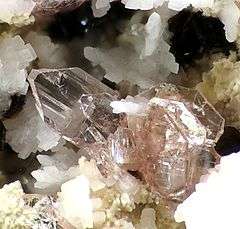Allactite
| Allactite | |
|---|---|
|
Picture width 3 mm | |
| General | |
| Category | Arsenate mineral |
| Formula (repeating unit) | Mn7(AsO4)2(OH)8 |
| Strunz classification | 8.BE.30 |
| Crystal system | Monoclinic |
| Crystal class |
Prismatic (2/m) H-M symbol: (2/m) |
| Space group | P21/a |
| Unit cell |
a = 11.03, b = 12.12 c = 5.51 [Å], β = 114°, Z = 2 |
| Identification | |
| Color | Brown, dark to light purplish red, brownish red, colorless to white |
| Cleavage | Distinct, {001} |
| Fracture | Uneven |
| Tenacity | Brittle |
| Mohs scale hardness | 4.5 |
| Luster | Vitreous, slightly greasy on fracture surfaces |
| Streak | Gray to faint brown |
| Specific gravity | 3.83 (meas.), 3.94 (calc.) |
| Optical properties | Biaxial (-) |
| Refractive index |
nα = 1.755–1.761 nβ = 1.772–1.786 nγ = 1.774–1.787 |
| Pleochroism | X = blood-red; Y = pale yellow; Z = sea-green |
| 2V angle | ~0° |
| References | [1][2][3] |
Allactite is a rare arsenate mineral of metamorphosed manganese zinc ore deposits. It is found in Sweden and New Jersey, US. Its name originated from Greek αλλάκτειν (allaktein) meaning "to change", referring to the strong pleochroism of the mineral.[2]
References
This article is issued from Wikipedia - version of the 11/21/2016. The text is available under the Creative Commons Attribution/Share Alike but additional terms may apply for the media files.
